My Stamp and Cover Websites
Introduction
I own a large collection of philatelic material of the flat press 11¢ Hayes stamp of 1922 (Scott 563). It consists of many First Day Covers (FDCs), full panes, plate blocks, die proofs, and postal history. I have been at this since about 1959 when I was introduced to the stamp. I have exhibited from my collection, published articles about parts of the collection, and have over the past ten years created a number of internet sites to provide extensive information and exhibits of this very interesting stamp. My interest does not extend to the rotary press 11c Hayes stamp of 1931 (Scott 692) which replaced the flat press version. My interest in that stamp pales when it is compared to the flat press stamp.
Scott 563 was printed from 1922 to 1931. My other philatelic interests also apply to the same time period. I collect all aspects of the 10¢ Special Delivery stamp of 1922 (Scott E12) which preceded the Hayes stamp. My websites for it cover FDCs, plate blocks, and die proofs. It and the flat press Hayes stamp were the first two new stamps released under a new postal administration that occurred with the election of Republican Warren G. Harding to President of the United States in 1920. W. Irving Glover became the new Third Assistant Postmaster General, the person responsible for stamps. It was a fortunate appointment since Glover was a savvy politician from New Jersey whose wife and political friends from New Jersey were stamp collectors. Glover would not only revise the design of all postage stamps, but would through various actions create the foundation for the modern FDC. Glover became the Second Assistant Postmaster General in 1925. His new responsibility was the movement of mail, particularly air mail. He managed significant advances in that area until his retirement in 1933. I also have a website for the Glovers.
Henry Hammelman was a pioneer FDC servicer, dealer, and exhibitor. I have spent several years researching Hammelman and his philatelic efforts and affairs. I have a website dedicated to him and his many FDCs. Even though Hammelman started out as a FDC servicer in 1913, his interest in air mail and first flight covers would by 1930 exceed his interest in FDCs. This website received the 2012 Philip H. Ward, Jr. award for excellence in FDC literature from the American First Day Cover Society.
I have two more sites dedicated to Henry Hammelman. They are studies of his first day treaty rate special delivery covers and his first flight covers.
I also have a study of misplaced “F” plate markings that are sometimes found on output from flat press printing plates.
Finally, in my spare time, I collect stamps, proofs, and postal stationery of the beautiful “Camel Postman” issues of Sudan.
Oops, I had some more free time. Another look at die proofs. My study of the 13 die proof sets of the Fourth Bureau Issue that got out of the Government and intact or not, mainly belong to collectors today.
Following are the links to my website articles, a dedication, and an 11c Hayes literature reference list. I make an appearance at the end of this website.
Most of my website articles have been converted to booklet form and are found in the APS Library.
Website Links
Click on click for choice
| click | The FDCs of the 11c Hayes Stamp of 1922 |
| click | The Plates and Sheets of the 11c Hayes Stamp of 1922 |
| click | The Die Proofs of the 11c Hayes Stamp of 1922 |
| click | The Color Varieties of the 11c Hayes Stamp of 1922 |
| click | Postal History of the 11c Hayes Stamp of 1922 |
| click | The FDCs of the 10c Special Delivery Stamp of 1922 |
| click | Plates and Sheets of the 10c Special Delivery Stamp of 1922 |
| click | The 10c Motorcycle Special Delivery Die Proofs |
| click | The Honorable and Mrs. W. Irving Glover |
| click | Henry Hammelman: Pioneer FDC Servicer, Dealer, and Exhibitor |
| click | Henry Hammelman’s First Day Treaty Rate Special Delivery Cover Collection |
| click | Henry Hammelman’s First Flight Cover Collection |
| click | A Study of Misplaced “F” Markings |
| click | An introduction to the Camel Postman of Sudan |
| click | Die Proof Sets of the Fourth Bureau Issue |
Each of my 15 websites may also be entered by clicking on an appropriate website title listed below. I have provided some philatelic color for each website.
The FDCs of the 11c Hayes Stamp of 1922
 My current census lists 74 known Fremont FDCs. This FDC, which is the only Fremont cover addressed to Edward C. Worden, was serviced by Michael Eidsness, the USPOD official who presided over the First Day ceremony at Fremont. Worden serviced only Washington D.C. FDCs for the Hayes stamp.
My current census lists 74 known Fremont FDCs. This FDC, which is the only Fremont cover addressed to Edward C. Worden, was serviced by Michael Eidsness, the USPOD official who presided over the First Day ceremony at Fremont. Worden serviced only Washington D.C. FDCs for the Hayes stamp.
.
.
The Plates and Sheets of the 11c Hayes Stamp of 1922
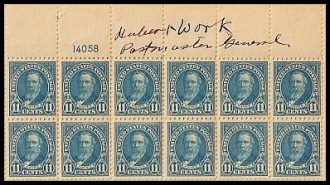 To commemorate the issue of the new Hayes stamp, USPOD and BEP officials autographed 32 panes of the stamp which were put on sale at the Philatelic Stamp Agency on the first day of issue. Most of the panes have been reduced to plate blocks with the signatures. PMG Hubert Work signed only one pane.
To commemorate the issue of the new Hayes stamp, USPOD and BEP officials autographed 32 panes of the stamp which were put on sale at the Philatelic Stamp Agency on the first day of issue. Most of the panes have been reduced to plate blocks with the signatures. PMG Hubert Work signed only one pane.
.
.
The Die Proofs of the 11c Hayes Stamp of 1922
 There could be as many as 14 Hayes die proofs in collector’s hands. All of them left the USPOD illegally as presentation gifts to U.S. Presidents, politicians, USPOD officials, BEP engravers, and friends and family. Nine of those die proofs are signed by Postmaster General Hubert Work. Even though three of them are printed in green or greenish shades, they are die proofs, not trial color proofs.
There could be as many as 14 Hayes die proofs in collector’s hands. All of them left the USPOD illegally as presentation gifts to U.S. Presidents, politicians, USPOD officials, BEP engravers, and friends and family. Nine of those die proofs are signed by Postmaster General Hubert Work. Even though three of them are printed in green or greenish shades, they are die proofs, not trial color proofs.
.
.
.
.
.
The Color Varieties of the 11c Hayes Stamp of 1922
 It is said that the Hayes stamp can be found in more color varieties than any other postage stamp printed by the Bureau of Engraving and Printing in the twentieth century. One color enthusiast in the 1930s was quoted as having single stamps in 76 different shades. The illustration here is a modest sample of the wide range of color.
It is said that the Hayes stamp can be found in more color varieties than any other postage stamp printed by the Bureau of Engraving and Printing in the twentieth century. One color enthusiast in the 1930s was quoted as having single stamps in 76 different shades. The illustration here is a modest sample of the wide range of color.
.
.
.
.
.
Postal History of the 11c Hayes Stamp of 1922
 Third class mail: San Francisco precancel on cover, dated July 26, 1926, covering 3 cents for a weight of 2+ to 4 ounces and 8 cents for a $5+ to $25 insurance indemnity. Legitimate use of solo Hayes stamp on a cover was very uncommon during the 1920s. It would become common during the mid 1930s for air mail sent to Europe.
Third class mail: San Francisco precancel on cover, dated July 26, 1926, covering 3 cents for a weight of 2+ to 4 ounces and 8 cents for a $5+ to $25 insurance indemnity. Legitimate use of solo Hayes stamp on a cover was very uncommon during the 1920s. It would become common during the mid 1930s for air mail sent to Europe.
.
The FDCs of the 10c Special Delivery Stamp of 1922
 This E12 FDC is addressed to Philip Ward, the noted dealer and philatelic journalist. It is the first FDC handled by the USPOD, via its Philatelic Stamp Agency, for a customer. All other FDCs on the E12 First Day were serviced in person by local Washington D.C. dealers and collectors.
This E12 FDC is addressed to Philip Ward, the noted dealer and philatelic journalist. It is the first FDC handled by the USPOD, via its Philatelic Stamp Agency, for a customer. All other FDCs on the E12 First Day were serviced in person by local Washington D.C. dealers and collectors.
.
.
Ward’s cover received special handling. The Agency typed in their return address (a familiar hand stamp would be used on the next First Day) and applied the wax seal of the Department of Stamps to the cover.
.
.
Plates and Sheets of the 10c Special Delivery Stamp of 1922
 Over a period of five years, 1922 to 1926, 69 flat press printing plates were used to produce 333 million copies of a new 10-cent special delivery stamp. The motorcycle messenger design replaced a bicycle messenger design which had been in use since 1902. The post office was mechanizing. Stamps are printed in a variety of ultramarine and gray-violet colors. This site displays plate number plate blocks and plate number singles for the different plate numbers.
Over a period of five years, 1922 to 1926, 69 flat press printing plates were used to produce 333 million copies of a new 10-cent special delivery stamp. The motorcycle messenger design replaced a bicycle messenger design which had been in use since 1902. The post office was mechanizing. Stamps are printed in a variety of ultramarine and gray-violet colors. This site displays plate number plate blocks and plate number singles for the different plate numbers.
.
The 10c Motorcycle Special Delivery Die Proofs
 Fourteen large die proofs, mainly as presentation gifts or through a die engraver’s retirement, left the premises of the Post Office Department and the Bureau of Engraving and Printing. They were pulled in four different colors: deep ultramarine (9), gray-violet (3), Reddish violet (1), and black (1). Two of the deep ultramarine proofs have not been accounted for.
Fourteen large die proofs, mainly as presentation gifts or through a die engraver’s retirement, left the premises of the Post Office Department and the Bureau of Engraving and Printing. They were pulled in four different colors: deep ultramarine (9), gray-violet (3), Reddish violet (1), and black (1). Two of the deep ultramarine proofs have not been accounted for.
.
.
The Honorable and Mrs. W. Irving Glover
 This Hayes FDC should be considered the first modern FDC. It is a Fremont cover addressed by Superintendent of Stamps Michael Eidsness (who presided at the first First Day ceremony) to his boss, Third Assistant Postmaster General W. Irving Glover who established the framework of public First Day announcements, significant First Day sites, and public ceremonies for the modern FDC in 1922.
This Hayes FDC should be considered the first modern FDC. It is a Fremont cover addressed by Superintendent of Stamps Michael Eidsness (who presided at the first First Day ceremony) to his boss, Third Assistant Postmaster General W. Irving Glover who established the framework of public First Day announcements, significant First Day sites, and public ceremonies for the modern FDC in 1922.
.
 The North Bend, Ohio plate block FDC serviced by Edward C. Worden contains a letter by Worden to Mrs. Glover explaining why the unofficial FDC city of North Bend should be considered as an official FDC city for Scott 622.
The North Bend, Ohio plate block FDC serviced by Edward C. Worden contains a letter by Worden to Mrs. Glover explaining why the unofficial FDC city of North Bend should be considered as an official FDC city for Scott 622.
.
.
Henry Hammelman: Pioneer FDC Servicer, Dealer, and Exhibitor
 Even though Hammelman’s first FDCs were serviced in 1913, it wasn’t until 1917 when he made any in quantity. For Scott 537, he made 25 FDCs with singles and a few with blocks. One of those covers is shown here with the familiar Hammelman handscript. Hammelman rarely used his own name on covers, but addressed them to his associates, the exception being covers made for his private collection.
Even though Hammelman’s first FDCs were serviced in 1913, it wasn’t until 1917 when he made any in quantity. For Scott 537, he made 25 FDCs with singles and a few with blocks. One of those covers is shown here with the familiar Hammelman handscript. Hammelman rarely used his own name on covers, but addressed them to his associates, the exception being covers made for his private collection.
.
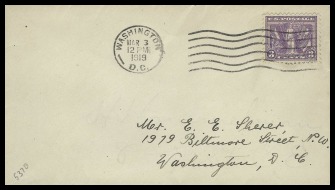 The second cover is considered to be a Hammelman FDC which was addressed by a Hammelman cohort for Hammelman’s inventory of covers. There is proof that some early Hammelman penciled covers to himself were erased and replaced with the names of other associates in this handwriting style; these actions taking place in the late 1920s.
The second cover is considered to be a Hammelman FDC which was addressed by a Hammelman cohort for Hammelman’s inventory of covers. There is proof that some early Hammelman penciled covers to himself were erased and replaced with the names of other associates in this handwriting style; these actions taking place in the late 1920s.
.
Henry Hammelman’s First Day Treaty Rate Special Delivery Covers
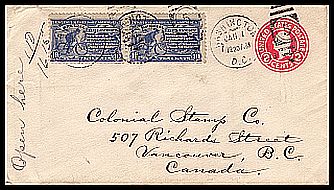 Prior to 1923, Canadian mail requesting special delivery service in the United States had to have a U.S. special delivery stamp. It was treated as ordinary mail if it had a Canadian special delivery stamp. This was also true for the reverse situation. A U.S./Canada treaty went into effect on January 1, 1923 that allowed the sending country’s special delivery stamps (20 cents) on mail requesting the service in the receiving country. The U.S. soon enacted similar reciprocities with more countries.
Prior to 1923, Canadian mail requesting special delivery service in the United States had to have a U.S. special delivery stamp. It was treated as ordinary mail if it had a Canadian special delivery stamp. This was also true for the reverse situation. A U.S./Canada treaty went into effect on January 1, 1923 that allowed the sending country’s special delivery stamps (20 cents) on mail requesting the service in the receiving country. The U.S. soon enacted similar reciprocities with more countries.
Henry Hammelman’s First Flight Cover Collection
 This FFC collection is based on a 1935 Hammelman check list, published by his firm, the Quality Stamp Company, of his significantly posted (blocks, booklet panes, and coil strips) FFCs. He continued to service covers until 1948. This is his 1936 Hindenburg FFC autographed by four crew survivors from the 1937 Hindenburg Lakehurst disaster.
This FFC collection is based on a 1935 Hammelman check list, published by his firm, the Quality Stamp Company, of his significantly posted (blocks, booklet panes, and coil strips) FFCs. He continued to service covers until 1948. This is his 1936 Hindenburg FFC autographed by four crew survivors from the 1937 Hindenburg Lakehurst disaster.
.
A Study of Misplaced “F” Markings
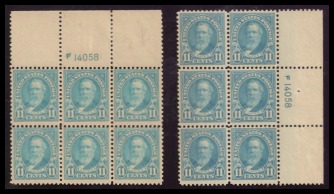 Finished flat press plates usually have a ‘F’ entered in front of the top plate number on the upper right pane. For the first Hayes plate, 14058, the ‘F’ was initially entered next to a side plate number on the plate. After some plate use, the ‘F’ was removed from the side position and applied to the plate at the usual top position. Plate 14058 is one of only four plates in the Fourth Bureau Issue in which side ‘F’ plate positions are found.
Finished flat press plates usually have a ‘F’ entered in front of the top plate number on the upper right pane. For the first Hayes plate, 14058, the ‘F’ was initially entered next to a side plate number on the plate. After some plate use, the ‘F’ was removed from the side position and applied to the plate at the usual top position. Plate 14058 is one of only four plates in the Fourth Bureau Issue in which side ‘F’ plate positions are found.
.
An Introduction to the Camel Postman of Sudan
 The Camel Postman series of Sudan stamps is equivalent to the Washington Franklin series of United States stamps. They were everyday ordinary stamps, all bicolor with the same Camel Postman design, printed from 1898 to 1948 in a variety of colors, watermarks, inscriptions, paper, denominations, and size.
The Camel Postman series of Sudan stamps is equivalent to the Washington Franklin series of United States stamps. They were everyday ordinary stamps, all bicolor with the same Camel Postman design, printed from 1898 to 1948 in a variety of colors, watermarks, inscriptions, paper, denominations, and size.
.
Die Proof Sets of the Fourth Bureau Issue
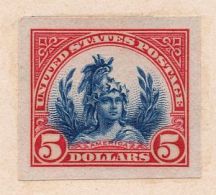 This section contains a brief study and history of each of the 13 die proof sets of the Fourth Bureau Issue that left the Government. One of the intact sets is displayed. There is considerable overlap with “The Die proofs of the 11c Hayes Stamp of 1922”.
This section contains a brief study and history of each of the 13 die proof sets of the Fourth Bureau Issue that left the Government. One of the intact sets is displayed. There is considerable overlap with “The Die proofs of the 11c Hayes Stamp of 1922”.
.
.
Dedication
My collection would not exist if it was not for the fortunate influence given me by three giants of philately. I dedicate my websites to them.
Lester G. Brookman
Authority and author on nineteenth century philately
I was a university student in 1959. Lester had a stamp shop in my home town of Minneapolis at that time. During a visit to his shop, I voiced concern about my collecting interests. As I would venture into a U.S. specialty (lined pairs, booklet panes, proofs, etc.), I would eventually lose interest as the cost of the specialty became prohibitive. He asked what I was currently collecting. I said revenues and that I enjoyed the shade varieties of some of the early revenue stamps. He thought for a minute and then went back into his vault and eventually came back with an album and several stocks books. It was a collection of the 11-cent Hayes stamp that had been assembled when the stamp was being printed and which focused on the countless shade varieties that the stamp is now known for. There were full panes ranging in color from blue to yellow-green and matched sets (plate numbers and colors) of plate blocks. It blew my mind. I ended up purchasing the collection piecemeal, as my wallet could afford it, but I had definitely become a Hayes color enthusiast.
Robert L. Markovits
Dealer, collector, exhibitor, author, and special delivery authority
I advertised as I sought to add to my Hayes collection. Bob Markovits became a source of new material. He eventually introduced me to FDCs. This was done when he convinced his friend Lawrence S. Fisher to part with a very significant Hayes Fremont FDC from Fisher’s wonderful FDC collection. That was my FDC start. Bob also introduced me to die proofs, postal history, and the 10-cent Special Delivery stamp of 1922.
Gary Griffith
Fourth Bureau Issue specialist and author
Gary was a fellow fourth Bureau Issue collector who I met through the United States Stamp Society. He helped me to become an author and exhibitor of material from my Hayes collection. He shared with me his enthusiasm for W. Irving Glover (and Mrs. Glover) who as an assistant postmaster general from 1921 to 1933 made many significant changes in Post Office Department attitudes and procedures that benefited collectors and the postal system. Gary’s book, The United States Fourth Bureau Issue 1922 – 1938, is my bible. It is a foremost philatelic authority on Glover and the Post Office Department of those years.
A belated word of thanks to Robert Colby of the AFDCS for his assistance in helping me to gather Hayes FDC information.
FDCs
Philip H. Ward, “Chronicles of New Issues and Varieties”, Mekeel’s Weekly Stamp News, Oct. 7, 14, 1922
The first report on the Hayes First Day.
Allison W. Cusick, “Modern First Days Began with Hayes Issue,” Linn’s Stamp News, April 27, 1987.
Good review of the Hayes First Day.
Jerry A. Katz, “First Day Covers of the 11c Hayes”, United States Specialist, Vol. 62, No. 9. Sep. 1991, pp 489-499. Initial survey and census of Hayes FDCs.
Jerry A. Katz, “11c Hayes FDC Census”, First Days, Vol. 44, No. 3, 1999, pp. 126-139.
More substantial census of Hayes FDCs.
Jerry A. Katz, “The 11c Hayes FDC Census: Updated”, First Days, Vol. 46, No. 3, pp. 192.
Update of prior First Days census.
Jerry A. Katz,”FDCs of the 11c Hayes Postage Stamp of 1922”, https://jerryakatz.wordpress.com.
Current survey of Hayes FDCs. Includes photos and background of the covers.
Jerry A. Katz, “1922 Rutherford B. Hayes”, First Days Archives, APS Library.
Photos of all known Hayes FDCs. Not current.
Color
L. E. Eastman, “11c Hayes, Series 1922”, Mekeel’s Weekly Stamp News, Apr. 28, 1930
First study of color variation.
Ross Frampton, “The Hayes Eleven Cent Stamp,” American Philatelist, Vol. 44, No. 5, Feb. 1931. pp. 235-244.
Best discussion of color variation. However, study performed before flat press Hayes stamp production ceased in 1931.
William H. Beck, “Color Analysis and Research in the Philatelic Art”, Weekly Philatelic Gossip,
Vol. 17, No. 4, Apr. 16, 1932, pp.97-100
Vol. 17, No. 5, Apr. 23, 1932, pp. 135-137, 152-155
Vol. 17, No. 9, May 21, 1932, p. 270 (Frampton’s comments)
Second best study of color variation.
Printing Color Varieties”, Stamps, April 25, 1953
Good introduction of hue, value, and chroma mentioned in Beck study.
Lewis A. Miers, “Odd Shades Among the Bureau Issues, Bureau Specialist, Vol.32, No. 5-6, 1961, pp. 375-379.
Good review of color variation.
Jerry A. Katz, “Color Varieties of the 11c Hayes Postage Stamp of 1922”, http://hayesshades.wordpress.com.
On-line study, using plate blocks, showing a substantial range of actual color variation. Blog still being developed.
Gary Griffith
Gary Griffith, United States Stamps 1922-26, Linn’s Stamp News, 1997, Chapter 5, pp. 65-70
The bible for the discussion of the flat press Fourth Bureau Issue. Much of the Hayes discussion in the following Griffith articles is contained in this book.
Gary Griffith, “Design Sources of the Fourth Bureau Issue, Part 2”, United States Specialist, Vol. 63, No. 12, Dec. 1992, pp.614-618
Gary Griffith, “Preliminary Designs and Essays of the Fourth Bureau Issue”, United States Specialist, Vol. 65, No. 4, Apr. 1994, pp. 152-158
Gary Griffith, “Engraving the Fourth Bureau Issue”, United States Specialist, Vol. 65, No. 9, Sep. 1994, pp. 390-398
Gary Griffith, “Die Proofs of the Fourth Bureau Issue.” United States Specialist, Vol. 65, No. 11, Nov. 1994, pp. 506-517
Gary Griffith, “In 1920s ‘30s, First Prints Got Signature Treatment, Stamp Collector, Vol. 74, No. 12, June 5, 2000, p. 12
Other
Max G. Johl, United States Postage Stamps, 1902-35, Quarterman Publications, 1976, pp.375-378
First textbook review of Hayes stamp (good color summary)
John Meek, “The 11c Rutherford B. Hayes (Scott 563)”, Bureau Specialist, Vol. 52, pp. 235-238.
More current review of Hayes stamp.
Jerry A. Katz, “Hayes Die Proof Presented at Fremont, Ohio,” United States Specialist, Vol. 65, No. 6, 1994, pp.258-260
H. M. Southgate, “The ‘Special’ Paper Printing of 1928”, American Philatelic Congress Book, No. 5, 1939, pp. 27-32
Wallace W. Cleland, “The ‘Special’ Paper Printings of 1928”, United States Specialist, Vol. 71, No. 9, Sept., 2000, pp. 397-401
Jerry A. Katz, “Plates 14058 and 14060 of the Eleven-Cent Hayes of 1922”, United States Specialist, Vol. 64, No. 3, March 1993, pp. 113-118
Jerry A. Katz, “Plates and Markings of the 11c Hayes Postage Stamp of 1922”.http://hayesplates.wordpress.com.
On-line study with many examples of the plates, sheets, and plate blocks of the Hayes stamp.
Jerry A. Katz, “Die Proofs of the 11c Hayes Postage Stamp of 1922”, http://hayesdieproofs.wordpress.com.
On-line history (and examples) of the Hayes die proof.
Arago Philatelic Reference Collection, “11-cent Hayes”, National Postal Museum. Google the following: “National Postal Museum” “11-cent Hayes”.
Some history, signed plate block and certified proof for plate 14060
Jerry A. Katz
USSS, AFDCS, APS
jerryakatz@aol.com
.
.
.
.
.
.
.
.
.
.


